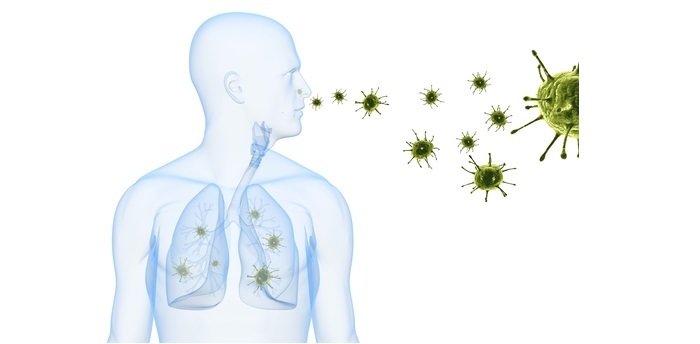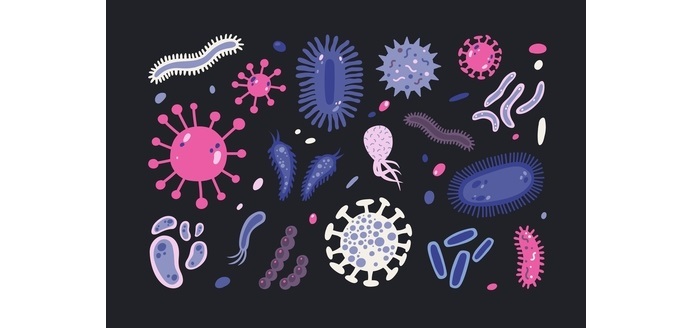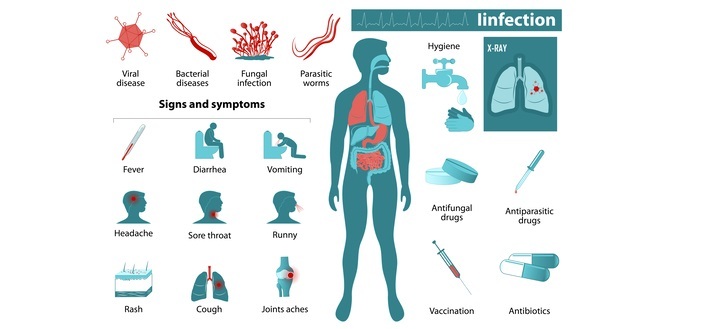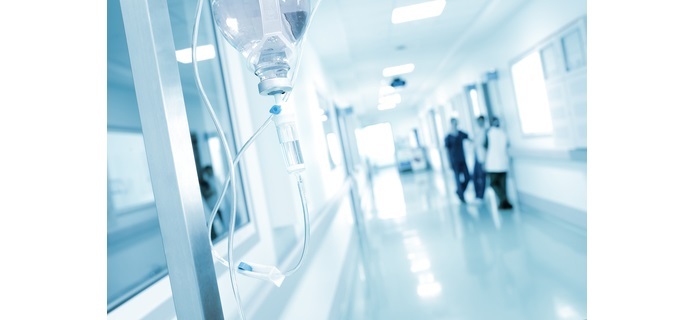
 Data Structure
Data Structure Networking
Networking RDBMS
RDBMS Operating System
Operating System Java
Java MS Excel
MS Excel iOS
iOS HTML
HTML CSS
CSS Android
Android Python
Python C Programming
C Programming C++
C++ C#
C# MongoDB
MongoDB MySQL
MySQL Javascript
Javascript PHP
PHP
- Selected Reading
- UPSC IAS Exams Notes
- Developer's Best Practices
- Questions and Answers
- Effective Resume Writing
- HR Interview Questions
- Computer Glossary
- Who is Who
Infection: Types, Signs, Symptoms, and Prevention
What is an Infection?
In clinical microbiology, to have knowledge of the basics one should learn to know a few very important terms like infection, immunity, disease, etc. The main terms infection and immunity are the effects which are resulted from an interaction between the host and a micro-organism.
Infection occurs when organisms find their way into the host body and grow in numbers beyond the level that the immune system is able to defend against. So infection usually occurs when the natural host's defenses like cilia, intact skin, gastric acid, and the immune system are compromised or overpowered. Infections may be caused by the sources like humans, animals, vectors and insects, etc.

Types of Micro-organisms
Infection is mostly caused when a person comes in contact with the bacteria, fungi, viruses, yeast, parasites and other micro-organisms in the following situations.
When a person comes in direct contact with the infected person.
Through an indirect spread when comes in contact with an environment.
By consuming contaminated food and water.
When comes in contact with an infected animal or insect.
Based on the relationship and interaction between micro-organism and the host, these organisms are divided into 2 groups. They are
Saprophytes - organisms which survive on dead and decaying organic matter.
Parasites - These are the organisms which can survive and establish in the host by even multiplying within the host body. These are again of 2 types which are pathogens and commensals.
Pathogens - These are the micro-organisms which have the ability to infect and cause a disease in the host body.
Commensals - These are the micro-organisms which can survive and exist in the host cell without causing any infection or disease. These are usually harmless. Host body consists of numerous commensals which can act as a facultative pathogen (These are normal microflora which can act only when the immune system of the host weakens, else it is harmless).

Steps Involved in Infection
Infection and infectious disease are the two terms which often gets confused for many people. Infection is the growth and multiplication of the parasite within or outside the cell whereas infectious disease is that when this parasite invades the cell and causes infection.
Following steps are involved in the occurrence of an infection.
Entrance of micro-organism into the body.
Microbial adherence or adherence of a micro-organism.
Entry in the host tissue.
Colonization or multiplication.
Organisms release toxins or pyrogens.
Spread of an infection in the host tissue.
Properties of an organism (infectious agent) which causes an infection
Organisms should be able to resist the host defense mechanisms.
Organisms should be able to cause disease unlike normal flora.
How Does an Infection Spread?
Spreading of an infection is also called as chain of infection which acts as a model guiding us to understand the process involved in spreading of disease.
In this chain, each step represents the transmission and all the links should exist in order to spread an infection.
Micro-organism (Pathogen) ? Reservoir (Living or non-living thing in which pathogen lives) ? Portal of exit (nose/mouth/wound) ? Mode of transmission (direct human to human transfer/indirect transmission through air/vector/object) ? Portal of entry (pathogen into new reservoir) ? susceptible host (Living thing where the infectious agent transferred to).
Symptoms and Signs of an Infection
Some symptoms of infection are listed below.
Fever
Chills and sweating.
Pain
Fatigue
Warmth, swelling and redness at the site of an infection.
Wound drainage/pus formation.
Necrosis.
Diarrhea
Vomiting
Depending on the type of infection, one may experience
Sore throat.
Cough
Running nose.
Shortness of breath.
Stiff neck.
Nasal congestion.
uncontrollable glucose levels.
Burning or pain during urination.
Frequent urination.
Unusual discharge (Vaginal/eyes).

Types of Infections
There are many types of infections observed. Some of the important ones are discussed below.
Primary Infection - infection which is caused when a healthy host cell is infected by a parasite for the first time is called primary infection.
Re-Infection - This is the infection occurred when a host cell is subsequently infected or re-infected by the same parasite.
Secondary Infection - This infection is caused by the new parasite due to the low immunity of the host cell with the presence of the pre-existing infectious disease.
Focal Infection - In this type of infection, an organism infects a particular organ or localized site but shows generalized effects on the body.
Cross Infection - Here the host who is already suffering from a disease is affected by a new infection.
Nosocomial Infection - The infections which are caused during a healthy person's stay at the hospital are called nosocomial infections.

Iatrogenic Infection - These are the induced infections caused by activities of surgeon during the investigation procedures, therapy or during medical or surgical interventions.
Endogenous infection - These infections are caused by the invasion of a previously existing infectious agent which was asymptomatic before.
Exogenous infection - This type of infection occurs when the bacteria which is previously existed in a closed system of the host body, now enter the sterile areas like the brain, muscle, etc., leading to an infectious disease.
Latent infection - These infections are caused by pathogens existing in the tissue of a host body and are in the latent phase previously which causes disease when a host's immune resistance is weak.
Congenital Infections - These infections are present in the host body by birth.
Acquired Infections - These infections are acquired by the host after their birth.
Pulminating Infections - These infections are suddenly caused and spread with severe intensity in the host.
Chronic Infection- These are long-duration infections and are projected severely during the entire course.
Inaparent or Subclinical Infections - These infections are confirmed only through immunological tests.
Diagnosis of Infection
The presence of infection or a bacterial invasion is usually detected and confirmed through the following procedures.
Symptomatic diagnosis.
Microbial culture.
Microscopy
Biochemical tests.
PCR based diagnosis.
Metagenomics sequencing.

Prevention and Control of Infections
Standard safety measures are to be followed for stopping the spread of an infection. Some of the measures include -
Proper handwashing.
Avoid sharing personal items.
Using the dis-infection techniques.
Safe food preparations.
Using appropriate bug sprays and repellants.
Always know about the travel risks.
Use of prophylactic (for special infections) or broad spectrum antibiotics (for various infections) to treat an infection.
Conclusion
Infections are usually caused as a result of microbial invasions. These infections may occur in many types starting with the birth and being a long-term in a host body. Infections mainly occur through the two types of microbial invasions.
These are active invasions where the infectious agent enters the host body and cause disease by disrupting the host defense system (example is Bacillary dysentery) and passive invasion where the pathogen enters the host body through the wound surface or any injury and causes the disease.
There are numerous factors which influence the cause of infections such as number and virulence of micro-organisms, resistance power of the host etc.

